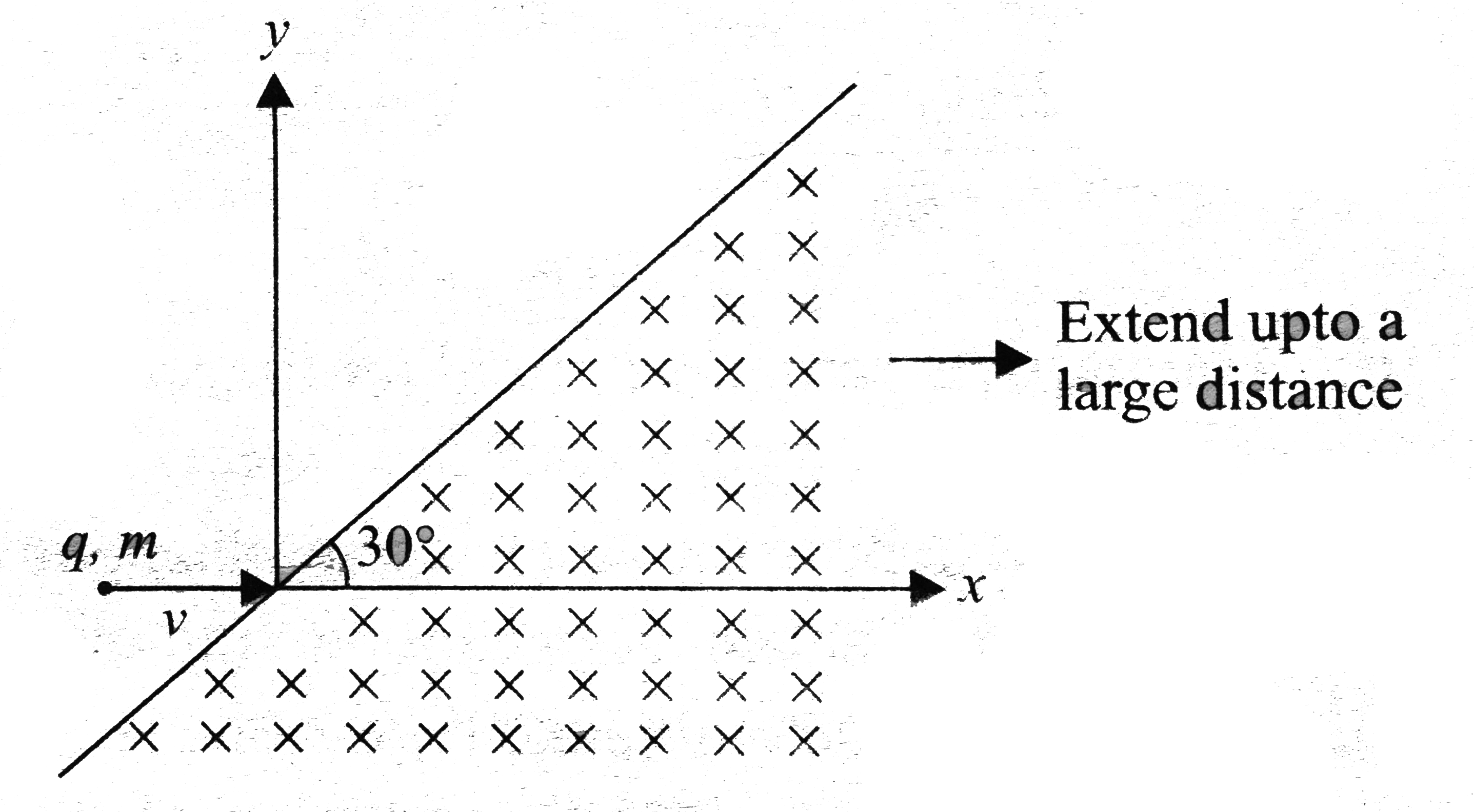A charged particle of unit mass and unit charge moves with velocity →v=(8ˆi+6ˆj)ms−1 in magnetic field of →B=2ˆkT. Choose the correct alternative (s).
(a) the path of the particle may be x2+y2−4x−21=0
(b) the path of the particle may be x2+y2=25
(c) the path of the particle may be y2+z2=25
(d) the time period of the particle will be 3.14 s
The correct Answer is:a,b,d
To solve the problem, we need to analyze the motion of a charged particle moving in a magnetic field. Here’s a step-by-step breakdown of the solution:
Step 1: Identify the Given Information
- Velocity of the particle: →v=8^i+6^jm/s
- Magnetic field: →B=2^kT
- Mass of the particle: m=1kg (unit mass)
- Charge of the particle: q=1C (unit charge)
Step 2: Determine the Magnitude of the Velocity
To find the magnitude of the velocity |→v|, we use the formula:
|→v|=√(vx)2+(vy)2
Substituting the values:
|→v|=√82+62=√64+36=√100=10m/s
Step 3: Check the Perpendicularity of Velocity and Magnetic Field
The velocity vector →v is in the xy-plane, and the magnetic field →B is along the z-axis. Since they are perpendicular, we can conclude that the motion of the charged particle will be circular.
Step 4: Calculate the Radius of the Circular Path
The radius r of the circular path can be calculated using the formula:
r=mvBq
Substituting the known values:
r=1⋅102⋅1=102=5m
Step 5: Calculate the Time Period of the Circular Motion
The time period T of the motion is given by:
T=2πmBq
Substituting the values:
T=2π⋅12⋅1=2π2=πs≈3.14s
Step 6: Determine the Path of the Particle
The path of the particle is circular in the xy-plane with a radius of 5 m. The general equation of a circle in the xy-plane is:
x2+y2=r2
Substituting r=5:
x2+y2=25
Conclusion
Based on the calculations:
- The radius of the circular path is 5m.
- The time period of the motion is approximately 3.14s.
- The equation of the path is x2+y2=25.
- Velocity of the particle: →v=8^i+6^jm/s
- Magnetic field: →B=2^kT
- Mass of the particle: m=1kg (unit mass)
- Charge of the particle: q=1C (unit charge)
To find the magnitude of the velocity |→v|, we use the formula:
|→v|=√(vx)2+(vy)2
Substituting the values:
|→v|=√82+62=√64+36=√100=10m/s
The velocity vector →v is in the xy-plane, and the magnetic field →B is along the z-axis. Since they are perpendicular, we can conclude that the motion of the charged particle will be circular.
The radius r of the circular path can be calculated using the formula:
r=mvBq
Substituting the known values:
r=1⋅102⋅1=102=5m
The time period T of the motion is given by:
T=2πmBq
Substituting the values:
T=2π⋅12⋅1=2π2=πs≈3.14s
The path of the particle is circular in the xy-plane with a radius of 5 m. The general equation of a circle in the xy-plane is:
x2+y2=r2
Substituting r=5:
x2+y2=25
Based on the calculations:
- The radius of the circular path is 5m.
- The time period of the motion is approximately 3.14s.
- The equation of the path is x2+y2=25.
Topper's Solved these Questions
- MAGNETIC EFFECT OF CURRENT AND MAGNETISMBOOK - DC PANDEY ENGLISHCHAPTER - MAGNETIC EFFECT OF CURRENT AND MAGNETISMEXERCISE - Comprehension type Questions
16 Videos
- MAGNETIC EFFECT OF CURRENT AND MAGNETISMBOOK - DC PANDEY ENGLISHCHAPTER - MAGNETIC EFFECT OF CURRENT AND MAGNETISMEXERCISE - Matrix Matching type Questions
12 Videos
- MAGNETIC EFFECT OF CURRENT AND MAGNETISMBOOK - DC PANDEY ENGLISHCHAPTER - MAGNETIC EFFECT OF CURRENT AND MAGNETISMEXERCISE - Only One Option is Correct
45 Videos
- LAWS OF THERMODYNAMICSBOOK - DC PANDEY ENGLISHCHAPTER - LAWS OF THERMODYNAMICSEXERCISE - Level 2 Subjective
18 Videos
- MEASUREMENT AND ERRORSBOOK - DC PANDEY ENGLISHCHAPTER - MEASUREMENT AND ERRORSEXERCISE - Subjective
19 Videos
Similar Questions
A charged particle of specific charge α moves with a velocity →v=v0ˆi in a magnetic field →B=B0√2(ˆj+ˆk). Then (specific charge=charge per unit mass)
View SolutionA charge particle of charge q and mass m is moving with velocity v as shown in fig In a uniform magnetic field B along -ve z-direction.Select the correct alternative (s).

View Solution
Knowledge Check
An electron is moving with an initial velocity →v=v0ˆi and is in a magnetic field →B=B0ˆj. Then it's de-Broglie wavelength
Aremains constantBincreases with timeCdecreases with timeDincreases and decreases periodically
A particle of charge per unit mass α is released from origin with a velocity →v=v0ˆi uniform magnetic field →B=−B0ˆk. If the particle passes through (0,y,0), then y is equal to
View SolutionAn electron is moving with an initial velocity →v=v0ˆi and is in a magnetic field →B=B0ˆj. Then it's de-Broglie wavelength
View SolutionAnswer the following:
(a) Write the expression for the force →F acting on a particle of mass m and charge q moving with velocity→V in a magnetic field →B . Under what conditions will it move in
(i) a circular path and (ii) a helical path ?
(b) Show that the kinetic energy of the particle moving a magnetic field remains constant.
View SolutionA positive charge particle having change q and mass m has velocity →v=v(ˆi+ˆk√2) in the magnetic field B at the origin . Its speed as the function of y is :

View SolutionWrite an expression in a vector form for the Lorentz magnetic force →F on a charge Q moving with velocity →V in a magnetic field →B. What is the direction of the magnetic force?
View SolutionA charged particle carrying charge 1μC is moving with velocity (2ˆi+3ˆi+4ˆk)ms−1. If an external magnetic field of (5ˆi+3ˆj−6ˆk)×10−3T exists in the region where the particle is moving then the force on the particle is →F×10−9N. The vector →F is :
View Solution1microC charge moves with the velocity →v=4ˆi+6ˆj+3ˆk in uniform magnetic field, →B=3ˆi+4ˆj−3ˆkxx 10^(-3). Force experience by charged particle in units of 10^(-9) N will be,
View Solution
